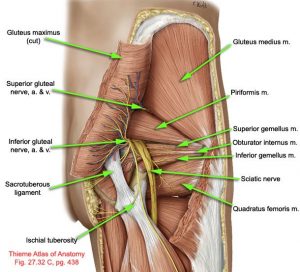Do you have frequent or ongoing pain down your legs that affects your life?
Sciatica is characterized by pain that originates in the low back or buttock that travels into one or both legs.

The pain is described as dull, achy, sharp, toothache-like, pins and needles or similar to electric shocks. Other symptoms associated with sciatica include burning, numbness and tingling sensations.
Sciatica is caused by nerve compression
Sciatica is generally caused by sciatic nerve compression. Disorders known to cause sciatic nerve pain include lumbar spine subluxations (misaligned vertebra), herniated or bulging discs (slipped discs), pregnancy and childbirth.
One common cause of sciatica is piriformis syndrome. The piriformis muscle is located in the lower part of the spine, connects to the thighbone, and assists in hip rotation. The sciatic nerve runs beneath the piriformis muscle. This muscle is susceptible to injury from a slip and fall, hip arthritis, or a difference in leg length. Such situations can cause cramping and spasm to develop in the piriformis muscle, thereby pinching the sciatic nerve and causing inflammation and pain.
Sciatic nerve compression may result in the loss of feeling (sensory loss), paralysis of a single limb or group of muscles (monoplegia), and insomnia.

Proper diagnosis of sciatica is essential
Since there are many disorders that cause sciatica, the chiropractor’s first step is to determine what is causing the patient’s sciatica. Forming a diagnosis involves a thoughtful review the patient’s medical history, and a physical and neurological examination.
Diagnostic testing includes an x-ray, MRI, CT scan and/or electrodiagnostic tests (nerve conduction velocity, electromyography). These examinations and tests help to detect possible contraindications to spinal adjustments and other chiropractic therapies.
Chiropractic treatment of sciatic symptoms
The purpose of chiropractic treatment is to help the body’s potential to heal itself. It is based on the scientific principle that restricted spinal movement leads to pain and reduced function and performance. Chiropractic care is non-invasive (non-surgical) and drug-free.
The type of chiropractic therapy provided depends on the cause of the patient’s sciatica. A sciatica treatment plan may include several different treatments such as spinal adjustments (sometimes called spinal manipulation), remedial massage, and ice/cold therapies.
Chiropractic’s limitations in treating sciatica
Sciatica can be caused by other disorders beyond the scope of chiropractic practice. If the doctor of chiropractic determines the patient’s disorder requires treatment by another type of doctor, then the patient is referred to another specialty. In some cases, the referring chiropractor may continue to treat the patient and co-manage the patient’s care with the other specialist.
70 years of
Experience & Practice
Discovering & treating the cause of your problems
Increase your function & be the best version of you
Our Services

Chiropractic
A health care profession concerned with the diagnosis, treatment and prevention of disorders of the neuromusculoskeletal system and the effects of these disorders on general health. There is an emphasis on manual techniques, including joint adjustment and/or manipulation with a particular focus on subluxations.

Remedial Massage
If you have particular muscle tension or chronic pain a remedial massage may be for you. Your remedial massage therapist will assess where you need treatment and what may be causing your pain. They’ll perform some tests to see exactly which muscles are giving you trouble and will tailor a treatment plan to suit.
Feel Better Today - $49 Health Check-Up
Come in for your Discovery Process to find out what are the causes of your symptoms.
Includes:
- Thorough consultation
- X-Rays
- Explanation of results
- Digital Postural Assessment

